Inside the Chinese city where more billionaires live than New York City once the richest city in China, it plans to get twice as rich in just 15 years
Marielle Descalsota

- Shenzhen, a city in southeastern China, is one of the billionaire capitals of the world.
- The city is home to some of China's wealthiest people, many of whom founded massive tech companies.
This is Shenzhen. It's where some 113 billionaires live — that's more billion-dollar residents than any city in the US.
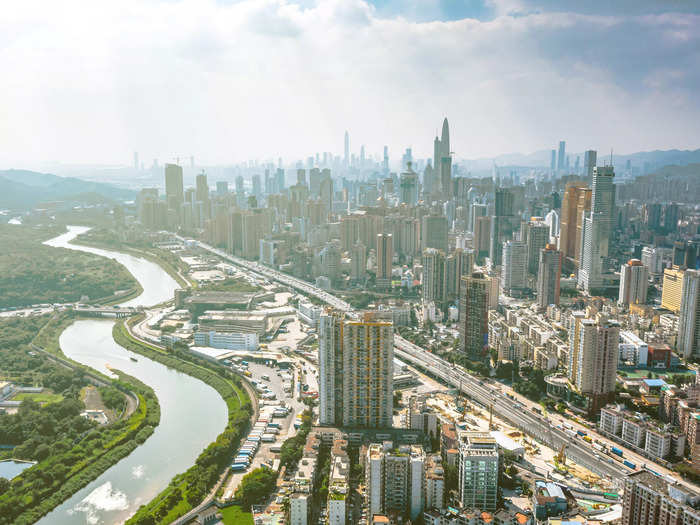
Once a small farming town, Shenzhen underwent a massive transformation in the last few decades to become one of the most prosperous cities in China. So prosperous, in fact, that it's the city where the most billionaires live — after two other Chinese megacities, Beijing and Shanghai, which are home to 144 and 121 residents respectively.
"There's a strong entrepreneurial spirit in the city. People come for one purpose — to get rich, to make money," Gu Qingyang, an economist and professor at the Lee Kuan Yew School of Public Policy, told Insider. Gu, who is educated in Singapore and China, conducts extensive research on the Chinese economy and policy.
While Forbes ranks New York City, the financial center of the US, as having the most billionaire residents in the world, it's a statistic that's widely disputed.
According to the Hurun Global Rich List, an annual ranking by Chinese private company Hurun, Shenzhen had pipped NYC as the city of choice for the ultra-rich. The list states there were 110 billionaires living in New York City as of January 14 — three less than Shenzhen.
Shenzhen's rise to become a hub for the super-rich was many years in the making, Gu said, adding that it was the first city in China to open up to reform and introduce a market economy.
Shenzhen became China's first Special Economic Zone in 1980. This meant tax exemptions, land subsidies, and more control in operating private businesses, which led to several companies — and entrepreneurs — becoming billion-dollar rich.
Shenzhen is located in southeastern China in the Guangdong province.
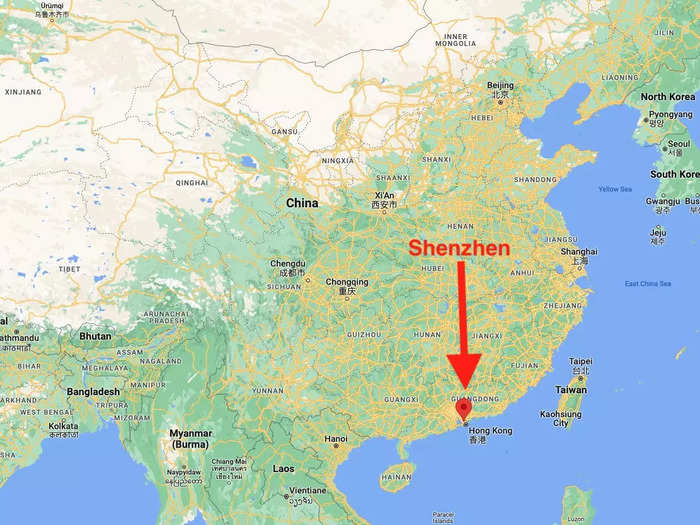
Shenzhen has a land area of around 2,000 square kilometers, or about 772 square miles, making it just slightly smaller than New York City, per a report by the Hong Kong Trade Development Council, or HKTDC.
Shenzhen is China's third biggest city with around 17.5 million residents, which means it's among the seven megacities in the country. The United Nations defines megacities as cities with over 10 million inhabitants. Before the city was developed in the 1980s, it had fewer than 30,000 residents, who lived mostly in villages, per the Guardian.
Sarah Tong, a senior research fellow at the National University of Singapore, described Shenzhen's population as "young and dynamic." Tong, who grew up in China and was educated in Beijing and San Diego, specializes in the Chinese economy and development.
"The government aimed to alleviate the problem of talent shortages through talent programs, attracting top Chinese universities to set up campuses in the city, and to establish a university of its own," Tong told Insider.
Located on China's east coast, Shenzhen's port is one of the largest in China. It's the third-busiest port in the world, with throughput traffic of 27.7 million in 2020.
Shenzhen is just a 30-minute drive from another major financial hub, Hong Kong. Its close proximity has played a big part in the city's emergence as one of the wealthiest in the country.
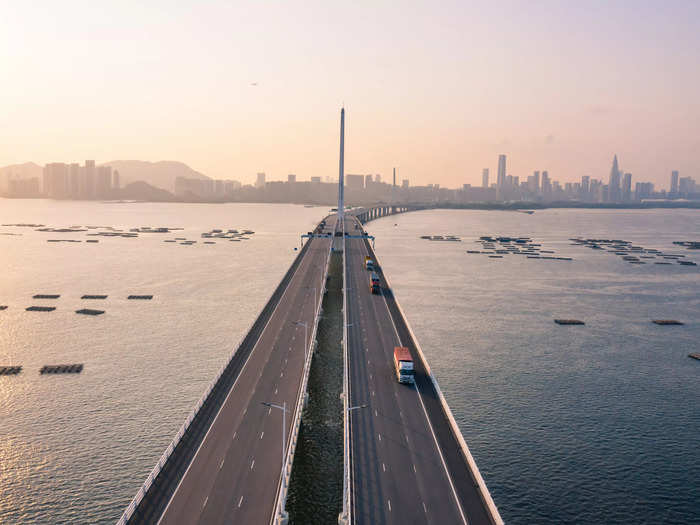
Shenzhen Bay Bridge, which completed construction in July 2007, connects mainland China to Hong Kong via Shenzhen.
"It's a competitive area," Gu said, referring to the Greater Bay Area, a project by the national government that aims to connect 11 cities in southern China into a vast economic network. The project has only spurred Shenzhen's astonishing growth.
In fact, Shenzhen has the highest gross domestic product among all the cities in the Greater Bay Area, raking in $475.3 billion in 2021, according to HKTDC. Shenzhen has a larger economy than countries like Norway, Ireland, and the UAE.
Shenzhen was once the richest city in China. In 2019, it had a GDP per capita of $29,498, per the state-run media outlet China Daily.
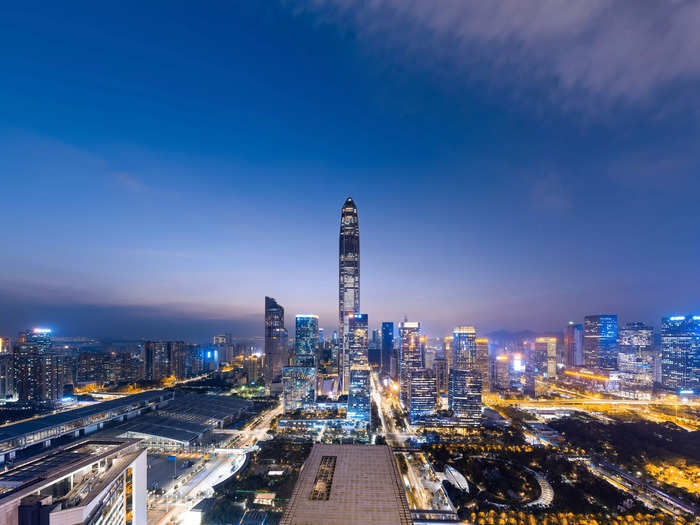
Shenzhen's GDP per capita has grown year on year since 2009, when it recorded just 87,359 Chinese yuan, data compiled by Hong Kong-based CEIC shows. In comparison, Beijing had a GDP per capita of $23,808, and Shanghai posted $22,779 in 2019, per China Daily.
Shenzhen's rapid financial growth can be attributed to China's scale of economy, Gu said. He explained that when compared to US cities, Shenzhen has not reached a state of maturity where "people already have everything."
"China is a huge country. The scale of economy is very large — one product and you can sell to the entire population," Gu said.
Gu explained that another reason for Shenzhen's rising GDP per capita is the billionaires themselves.
"Billionaires living in the city bring in huge business," Gu said. "They bring in innovation and create employment and government revenue," he added.
Ma Huateng, who also goes by Pony, is the richest man in Shenzhen. He's worth $25 billion, making him the fourth-wealthiest man in China, according to Forbes.
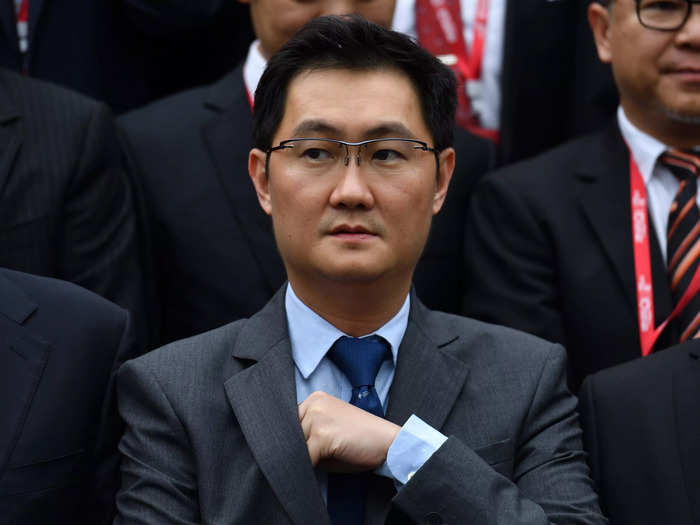
Several of the wealthiest individuals in Shenzhen moved to the city before becoming billionaires, according to Gu. Ma, the CEO of Chinese internet conglomerate Tencent, is the most high-profile of them.
Ma moved to Shenzhen as a child from Shantou, another city in Guangdong with his father, per Bloomberg. He graduated from Shenzhen University in 1993 and founded Tencent five years later. Today, Ma continues to reside in Shenzhen as Tencent is headquartered in the city, per Forbes.
Of course, Ma's not the only billion-dollar CEO living in town.
Wang Chanfu, the CEO of China's largest automotive manufacturer BYD Company, is also based in Shenzhen. Wang moved from Beijing to found BYD in 1995, per Bloomberg.
Wang has a net worth of $19.6 billion, according to Forbes.
Shenzhen is nicknamed the Silicon Valley of China.
Shenzhen is home to some three million enterprises, according to the South China Morning Post, citing official data.
Unlike other parts of China, Shenzhen is a city built on private enterprise, according to the Institute for Management Development. And like Silicon Valley, Shenzhen is where many of China's biggest tech giants have set up shop, including Tencent, mobile phone corporation Huawei, and DJI, the world's largest drone maker.
But Tencent is by far Shenzhen's biggest success story.
Founded in 1998, Tencent wasn't profitable until its fourth year in business. Tencent was founded by several Chinese entrepreneurs — and one of them was Pony Ma.
Now, Tencent is the largest Chinese company by market capitalization, with a market cap of $303.32 billion. It's also the world's largest video game corporation, with a revenue of $8.121 billion — beating out the likes of Apple, Microsoft, and Google.
Tencent owns some of the world's most popular video games, including Fortnite, League of Legends, and messaging app WeChat.
Shenzhen still wants to keep growing richer, despite already being one of the wealthiest cities in China.
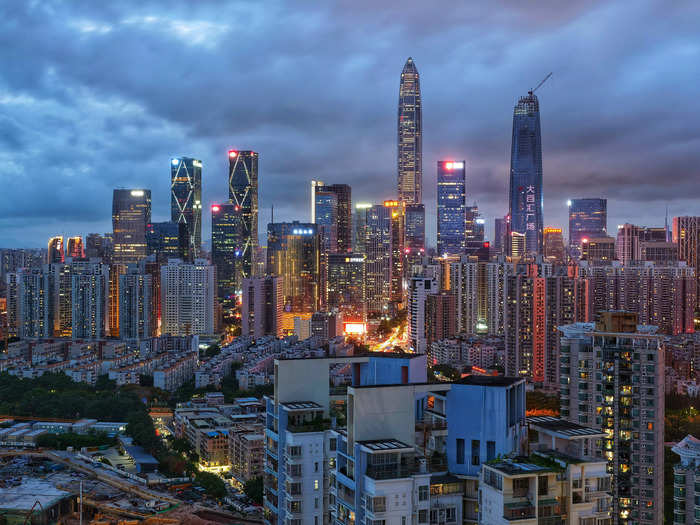
Shenzhen's goal is to double its total and per capita GDP in just 15 years, per the SCMP, citing a blueprint released by the local government in December. Shenzhen has already grown its economy by five times in the last 14 years alone, increasing its GDP from 580 billion yuan in 2006 to 2.8 trillion yuan in 2020, reported the SCMP.
While Shenzhen's economic growth was initially spurred by its robust manufacturing industry, the city also invested heavily in a high-tech, internet-based economy, Gu said.
"Shenzhen wants to be a hub for financial centers, blockchain, and digital industries," Gu added. "These high-end services will play a big role in its growth and wealth."
Now, to sustain the city's year-on-year growth, the Shenzhen government plans to develop the integrated circuit, artificial intelligence, and biomedicine industries, per the local government's blueprint. It also plans to allocate at least 30% of the city's scientific research fund to research and development.
But Shenzhen's rapid growth and billionaire presence are not all good news — it's one of the most expensive cities to live in China, which means it can be tough for some residents to make ends meet.
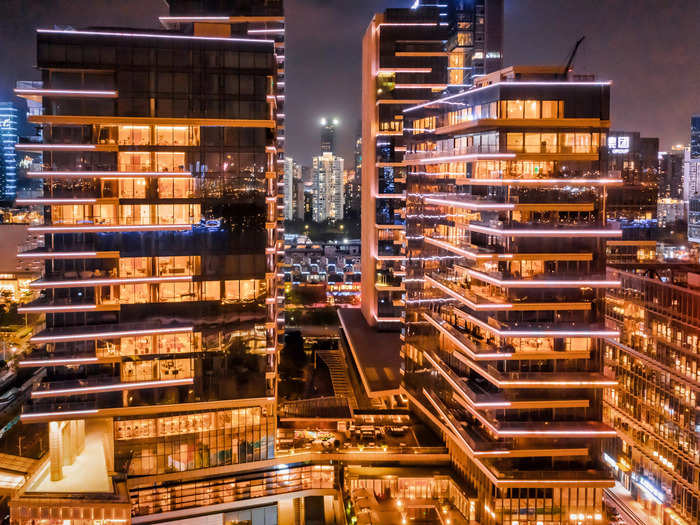
Locals in Shenzhen can be extremely wealthy — some 300,000 locals who have lived in the city prior to its development have a combined fortune of more than $30 billion, per a 2021 Bloomberg report.
But the rising costs of living have been crushing for Shenzhen's less wealthy residents, many of whom are migrants from other parts of China, Gu said, adding that it's difficult for many people to buy homes.
According to CBRE's Global Living report, Shenzhen's properties cost over $680,000 on average, putting it in the top five most expensive real estate markets in China. Shenzhen is quickly becoming a luxury real estate market too, when it beat London, New York City, and Paris in luxury home price increases from 2020 to 2021, growing by 18.9%, per the SCMP, citing consultancy firm Knight Frank.
"It seems like there's no shortage of wealthy people in Shenzhen. New houses sell out as soon as they come onto the market and second-hand homes can be even more expensive than new ones," Zheng Meng, a Shenzhen resident since 2014, told the property news blog 90 Degree Real Estate, adding that she "still can't afford a house" despite saving up for seven years.
Those who cannot afford to live in high-end properties end up in Shenzhen's "chengzhongcun," or villages in the city.
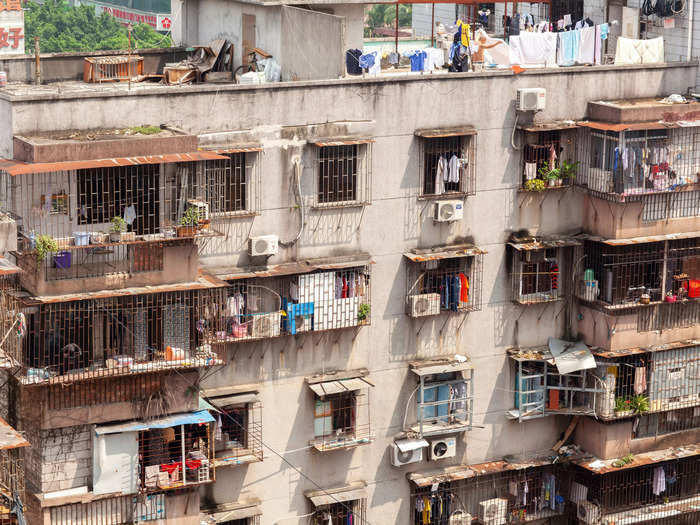
"The city's future development is also marred with constraints and challenges," Tong said, adding that low-income people working in traditional service sectors are affected the most.
Shenzhen has attracted migrants from all over China because of its traditionally lax hukou policy, which means people might be able to immigrate to the city more easily than in other parts of the country, per a 2008 report by the CECC.
"We are part of Shenzhen's urban development, but we are being excluded," Zhang Songmei, a Shenzhen resident who lives in one of its urban villages, told SCMP.
Some 70% of Shenzhen's residents live in "handshake buildings" in these chengzhongcun, where apartments are so tightly packed together they nearly touch, Bloomberg reported.
"I don't have any plans for the future," Chen Zhengyu, another resident living in an urban village, told Al-Jazeera. "I don't see myself living in those houses in the future, and it is not something for me without a college degree."
Gu explained that most of the properties are too expensive for ordinary people as they are built by private developers.
"It's a market system — only if you have the money you can buy luxury housing," he said, adding that Shenzhen has started developing a public housing scheme, which aims to resettle 60% of the city's residents into government housing by 2035.
Shenzhen's skyrocketing wealth and living costs have resulted in high income inequality.
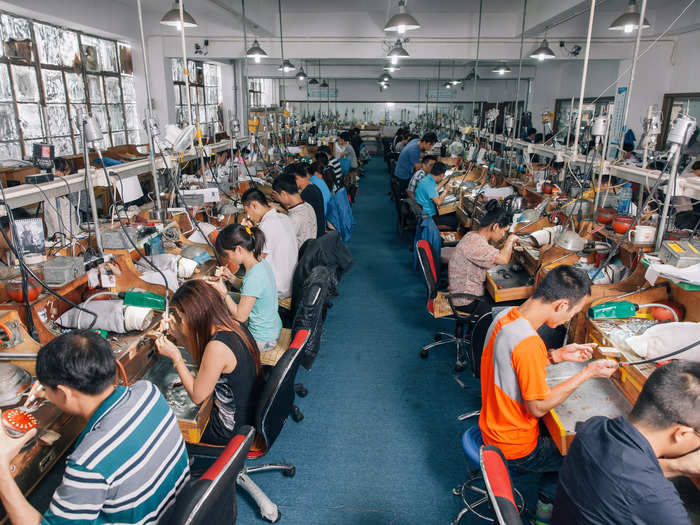
According to a 2017 paper in the International Journal for Equity in Health, Shenzhen's Gini coefficient was 0.447, which meant that the city's income inequality was even higher than China's capital, Beijing. And in China, the top 1%, which includes Shenzhen's billionaires like Ma and Wang, hold a greater share of wealth than the entire half of the country's population of 1.4 billion people, per a 2020 report by Bloomberg.
In Shenzhen, residents and workers don't need to live below the poverty line to struggle financially, with an apartment in the city costing 43.5 times the average person's annual salary, reported Bloomberg.
"It's improved in the past decade but the living costs are very high for locals," Gu said, adding that it's "very difficult for the ordinary people to survive."
Popular Right Now
Popular Keywords
Advertisement